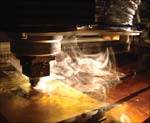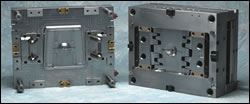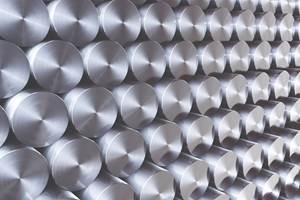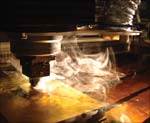IDEAS, INC.: Good Thinking!
This moldmaker’s decision to venture into the rapid tooling market added up to rapid growth—and the winning of the 2006 Leadtime Leader Honorable Mention: Small Shop for the second year in a row.
Eight years ago, IDEAS, INC. (Uniontown, OH)—a comprehensive product development and contract manufacturing firm for the industrial and medical electronics industries as well as serving automotive components, office products, and lawn and garden products—forayed into the rapid tooling (RT) market with the creation of its Rapid Tooling Group (RTG). It was a decision that would propel them into annual sales of more than $12 million and sales growth of 579 percent over the past three years and make them the Leadtime Leader Honorable Mention for two years running.
IDEAS could have simply enjoyed its success; after all, it had more business coming in every day. However, the company has managed to enter two different areas over the past year: mold sampling and low-volume contract manufacturing. This savvy business decision, combined with a move into a new facility and the addition of several personnel, has poised them for unprecedented profit and growth. According to IDEAS President/CEO Brad Borne, the new building is three times larger than its old facility, and as far as manufacturing space, it is four times the space the company had before. In addition to housing the RTG, the new facility houses the Product Development Group (PDG) and a subsidiary that specializes in low-volume contract manufacturing. The company employs six moldmakers/tooling engineers (RTG), seven industrial designers and mechanical engineers (PDG), one QA/CM manager, two in the front office, and anywhere from one to five temps depending on the workload.
An Idea Forms
So why did this already successful product development firm decide to enter a new market? In two simple words: customer satisfaction. Borne’s experience in product development with companies like IBM, Lexmark and Telxon had left him with a customer’s perspective, and he felt this would give him an added edge. “In 1994, our projects were suffering because of the leadtimes required to build high quality production molds,” Borne recalls. “It always came down to leadtime, quality or price—choose two out of three.” So he took 18 months to conduct enough research to feel confident in creating the RTG, a stand-alone profit center within the company, designed to build quality production molds at competitive pricing with compressed leadtimes. By using the RTG instead of outsourcing molds, leadtimes immediately began to slim down to today’s average of 3.8 weeks.
“The company’s approach to RT is not the same as an average mold shop,” Borne notes. “We evaluated all of the rapid prototyping (RP) technologies that could be applied toward RT, and found that in some cases, these technologies did provide some time savings,” he says. “But, their use was limited to simple parts and the tolerances and finishes were not up to production standards. So, we decided to use non-traditional methods combining the use of ultra-high-speed machining techniques and an integrated CAD/CAM (Pro/E)-driven, lean process. A well-managed and thoroughly scheduled process provides limited queue time, if any, for any given mold component. We can deliver SPI Class 101 through SPI Class 103 molds, single cavity up to 32 cavities or multi-part family molds through this accelerated, technology-driven, mold building process.”
Perfecting a Process
The RTG’s mold design and build process leverages software, machine tools and people, and is heavy on the engineering side. Borne’s staff is made up of mostly engineers and programmers, with craftsmen to complete the mold building process. The company built its RT process on a fully integrated 3-D CAD/CAM platform, so it designs, manufactures and verifies molds in a virtual environment in order to automate a majority of the mold build process—resulting in cost and leadtime advantages. “We feel there should be low man-time in every job,” he explains. “Our people map the processes or strategies that allow the machines to do the majority of the work. Craftsmen should only step in during final assembly or polishing—where a machine may not be viable or justifiable.”
Borne stresses that CNC equipment performs 90 percent of the work that runs unattended, with the help of palletizing equipment. “This equipment has further minimized the man hours required for setup and is the first step to robotic automation,” Borne states. “Our entire process is led and monitored by a strategic project management system that we have developed in-house that guarantees a smooth flow and leverages our investment in technology.” The system—a combination of “constantly evolving” software packages—is being ported to a web interface and will be introduced to select clients later this year.
The company already uses a Japanese manufacturing system created by Toyota that strives to totally eliminate waste. Called Just-in-Time manufacturing (JIT), this philosophy dictates that equipment, resources and labor are to be used only in the amount required and at the time required to do the job. As an example, the company performs very little work to its mold bases. Borne points out that mold base manufacturers do an excellent job with mold base customization, and he prefers to leave that work to the experts.
To train his employees, Borne relies on a combination of manufacturer-provided tutorials with work he assigns. “We require all RTG personnel to learn Pro/E to some degree,” he says. “Most will learn 3-D design basics and continue on one of the following training paths: CNC programming, electrode design, mold design or drafting.” He also looks to his most experienced staff for assistance. “Once our moldmakers become software gurus, they are ‘tooling engineers’ that are capable of completely designing very complex molds or creating advanced CNC machining routines, as well as advanced assembly, surfacing tasks and electrode design.”
Expanding Operations
Borne’s decision to move into a bigger, better facility paved the way for its mold sampling and low-volume production as well as assembly operations. “We are now seeing a lot of demand for these services,” Borne emphasizes. “We are providing our customers with an optimized mold processing scenario so that they can bring a mold into their injection molding vendor with a proven process and limit the amount of downtime required to get into production. When a client wants a mold built in three weeks, they don’t have time to ship that tool across the country or the world. We can run them enough parts to buy them some time. It’s beyond what most mold shops do—some of the bigger moldmakers justify the expense and our customers tell us it’s quite helpful.
“We’ve noticed a big improvement in mold sampling now that we control that process,” Borne adds. “Not that the injection molders aren’t capable of providing this level of service, there is just no incentive for them to do so. We used to sub-contract with local injection molders to sample a mold. They get paid the same amount whether they spend one hour or 10 hours sampling a mold, so it goes without saying the incentive is to get it done fast. Now we can take our time and thoroughly prove out a mold, or even provide Design of Experiment (DOE) time. Simply put, we’ve taken control of one more step in the process. It’s not unlike how we entered the mold building business—our customers spoke and we listened.”
The company’s small assembly line is a modular work space that can be shuffled around, broken down and reassembled depending on customer demand. “It can be one big cell or smaller cells,” Borne notes, “which allows us to be flexible in meeting our customers’ demands.” Borne adds that the assembly service is, “more attractive in the U.S. because of the quick turnaround. There aren’t a lot of companies out there that offer high quality, low-volume assembly.”
Investment in the Future
Over the next year, Borne plans to strengthen—and grow—the aforementioned areas so the company can continue to provide the end-to-end services that its customers have come to expect. “This quarter we are on track to do more business than we did in the first nine months of last year,” he emphasizes. “We have positioned ourselves to provide world-class industrial design, engineering, RT, molding and contract manufacturing services.”
Additional plans include raising the bar for its customers by experimenting with molding different materials. “These companies don’t want to take a mold out of the press just to experiment or wait for an opening, so this is a great opportunity for them,” Borne stresses. “Not every production molder has presses sitting around just for sampling. Sampling is a necessary evil for a molder; and they’d prefer the moldmaker to do the sampling if possible, so they don’t have to mess with it. Of course many would like to be involved in the sampling process, and we always make that option available to them. So now it’s not a necessary evil but a service we provide.”
Borne is not afraid to invest wisely in IDEAS’ future. “We have—and will—invest regardless of current profitability or economic outlook, which has only a minor influence on investment,” he asserts. “We perform needs-based assessments throughout the year that identifies processes targeted for improvement. Our staff constantly evaluates the ‘gates’ in our process. Everyone’s voice is heard; in fact, they are encouraged to critique our process and make suggestions that would improve the company and make their lives better. Once identified, the management team evaluates these areas of improvement and balances the return against the cost and the cost of not doing anything. From this assessment we create a justifiable budget based on proven gains, which are usually calculated with the help of benchmarking equipment and changes in process.”
More investments will encompass a robot that will load and unload work and the tools specific to performing each job. Then, Borne notes he will palletize the entire shop—presetting all work coordinates offline and adding robots for inspection as well as other automated equipment. Additional machinery will be purchased and an FDA-certified cleanroom will be added for medical molding products this year. Clearly, Borne and IDEAS are comfortable with thinking outside of the box to get the job done effectively and competitively.
Related Content
Laser Welding Versus Micro Welding
The latest battle in finely detailed restoration/repair of mold materials.
Read MoreWhat You Should Consider When Purchasing Modified P20 Steel
When buying P20 steels that have been modified, moldmakers must be aware of the variations and key issues that affect delivery, cost and lead times.
Read MoreMaking Quick and Easy Kaizen Work for Your Shop
Within each person is unlimited creative potential to improve shop operations.
Read MoreMold Design Review: The Complete Checklist
Gerardo (Jerry) Miranda III, former global tooling manager for Oakley sunglasses, reshares his complete mold design checklist, an essential part of the product time and cost-to-market process.
Read MoreRead Next
IDEAS, INC.: Thinking Outside the Box
Entering the rapid tooling market resulted in a rapid growth spurt for this moldmaker—earning them the 2005 Leadtime Leader Honorable Mention: Small Shop.
Read MoreHow to Use Continuing Education to Remain Competitive in Moldmaking
Continued training helps moldmakers make tooling decisions and properly use the latest cutting tool to efficiently machine high-quality molds.
Read MoreReasons to Use Fiber Lasers for Mold Cleaning
Fiber lasers offer a simplicity, speed, control and portability, minimizing mold cleaning risks.
Read More





















